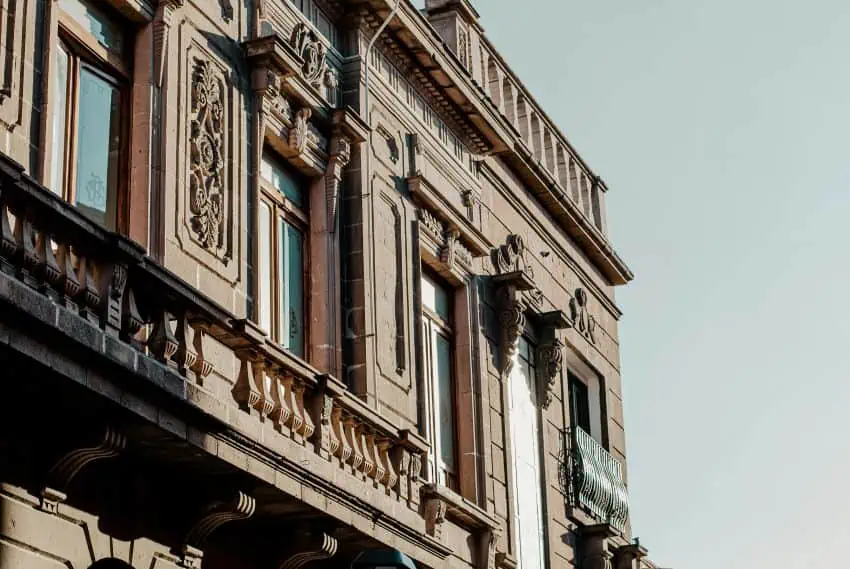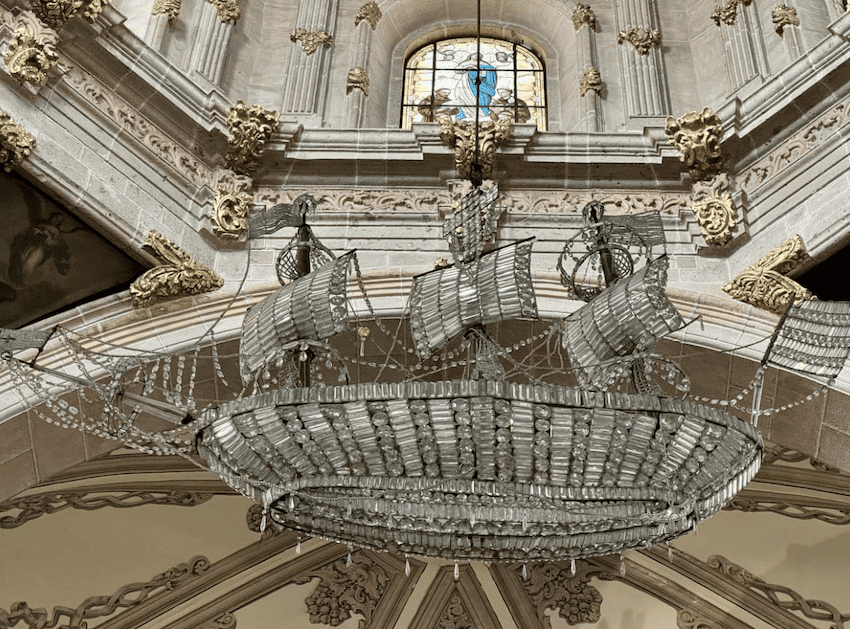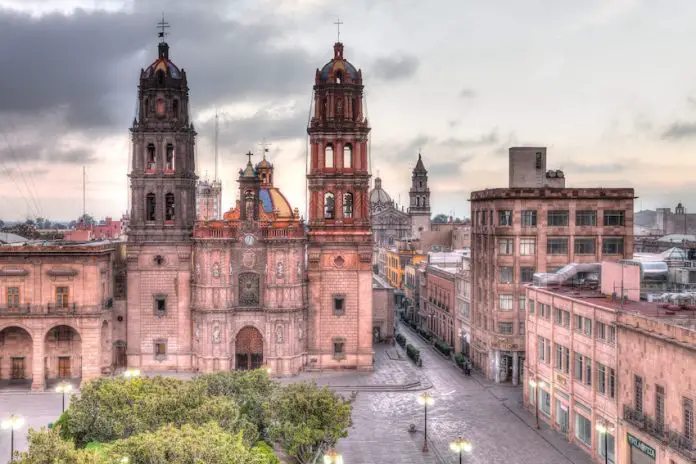Strolling along San Luis Potosí’s tree-lined, pedestrianized street, the Calzada de Guadalupe, I pondered why I hadn’t seen a single foreign tourist in the city. San Luis, as the locals call it, is a beautiful town whose historic center was named a UNESCO World Heritage site in 2018. Made up of 42 streets, the downtown area is home to 500 historic monuments, Baroque and neoclassical structures and old stone manors that have been now been remodeled into museums, shops, and restaurants.
It’s hard to pick the very best that San Luis Potosí has to offer, but here are some of the highlights:

The Longest Pedestrian Street in the Americas
This two-mile walk is technically a number of different streets that have all become pedestrianized. The trail begins at the Hidalgo Market, continues to the Plaza de Armas – home of the neoclassical Metropolitan Cathedral – then along the shopping street of Zaragoza, and from there turns into the Calzada de Guadalupe, ending at the Basilica of Guadalupe.
The Water Tank on the Calzada
The graceful neoclassical 19th century Caja de Agua (water tank), the last remaining reservoir in the city, stored water brought by the aqueduct. In that era, structures were obviously designed to be not just functional, but beautiful. Although the Caja de Agua had a rope cordoning it off, we enjoyed watching a bridal couple ignoring the barrier and having their photos taken in front of it. Near the water tank is a 19th-century statue of a water boy (El Aguador) carrying water in a terracotta jug to nearby houses.
The Leonora Carrington Museum
Towards the end of the Calzada is a long, low building with castle-like turrets and thick walls. It turns out it’s a former prison, now home to the Leonora Carrington Museum. Carrington was a British-born Mexican artist and one of the last great Surrealists of the twentieth century.
Carrington’s path from London to Mexico City was a twisted one. She met the famous surrealist artist Max Ernst in London, and in 1937 they ran away together to France. When the war broke out, Ernst was arrested in Germany while Carrington escaped to Spain, where she had a mental breakdown. After she recovered, she went to the Mexican Embassy where Renato Leduc, the Mexican ambassador, agreed to a marriage of convenience with her so that she would be given immunity as a diplomat’s wife. The couple sailed for New York and later settled in Mexico City, where their marriage ended amicably. Carrington lived and worked mainly in Mexico for the rest of her life.

In the museum, her bronze sculptures, often hybrid figures, half human and half animal, look bizarre, especially against the stark backdrop of a former prison. Hyenas, horses, crows, half-crocodiles, winged pigs, and giant women recur throughout her work. One sculpture shows a woman with an animal head wearing a long elegant gown. Her paintings tend to be dreamlike, steeped in myth, mysticism, and folklore.
Why a museum dedicated to Carrington in San Luis Potosí, of all places? One of the museum staff told us that because of her history with mental illness, Carrington found the idea of a former prison housing her art appealing and oddly appropriate. Also, she was a friend of another Surrealist, fellow Brit Edward James, who lived in Xilitla, a pueblo mágico in the area of the state known as the Huasteca Potosina. In Xilitla, he designed a whimsical sculptural garden called Las Pozas.
The Basilica of Guadalupe
Just beyond the museum is the Basilica of Guadalupe, an important church for locals. December 12 is the Day of the Virgin of Guadalupe, a popular feast day that celebrates the anniversary of the appearance of the Virgin Mary, Mexico’s patron saint, in Mexico City. On that day, hundreds of faithful crawl for about a mile on their knees along the Calzada to the church.

The church also houses one of two crystal ship chandeliers that hang in different local churches, with the other located in the nearby Church of San Francisco. The chandeliers, dating to 1788, were commissioned as a tribute by sailors who believed St. Francis saved them from a shipwreck. Shaped like a caravel, the boat used in Portuguese and Spanish colonial expeditions, they were originally donated to St. Francis’s church in Real de Catorce, an isolated mining town north of San Luis. Church authorities considered the chandeliers too important to be stuck in such a remote town and decided to move them to the state capital of San Luis Potosí.
Plaza de Carmen
A lovely place to hang out and watch people, the plaza is ringed with two museums, a theater and the Templo de Carmen (an example of Churrigueresque Baroque architecture. You can’t help but notice an eerie bronze sculpture, “El Cofrade” (the friar), which to Americans looks like a Ku Klux Klanner. The sculpture symbolizes one of the brothers who walks in the Procession of Silence, a solemn event held on Good Friday, beginning at the El Carmen Church and winding through the historic center.
Tangamanga Park
Tangamanga is the second largest urban park in Mexico, after Chapultepec in Mexico City. “But it has more trees!” boasted our taxi driver. Indeed, the huge park has more trees than any park I’ve seen in Mexico, along with a lake and a two-mile paved trail for walking, running, and cycling.
An interesting detail about the park is that it has two water treatment plants for irrigation and its compost.
The Train Museum
If you’re a railway enthusiast, you’ll enjoy the kid-friendly train museum, the Museo del Ferrocarril, the best part of which is the trains themselves, which you can climb aboard. Check out the model train layout on the second floor.
Cerro de San Pedro

The birthplace of San Luis, San Pedro is a tiny mining village 40 minutes from the city, where gold and silver were discovered in 1592. You can walk for miles and visit a mine. It’s mostly deserted during the week but can get crowded on weekends.
We were in San Luis Potosí for four nights, but could easily have spent a full week there, and I’m already looking forward to another visit.
Where to Stay
We stayed at the Gran Concordia, a mid-range hotel a block from the Plaza de Armas. Breakfast is available for an extra fee. It was amazing to go from the busy street scene, filled with vendors and musicians, and two minutes later be relaxing in the quiet oasis of our room.
Where to Eat
La Oruga y la Cebada is a family-style restaurant with a terrace restaurant. Great shrimp tacos.
La Posada del Virrey, on the Plaza de Armas, has both indoor and outdoor seating. We enjoyed the mojitos (which weren’t on the menu).
For early risers, Cafe Tokio, a typical Mexican (not Japanese!) restaurant with booths, opens at 7 am and offers generous Mexican breakfasts.
Louisa Rogers and her husband Barry Evans divide their lives between Guanajuato and Eureka, on California’s North Coast. Louisa writes articles and essays about expat life, Mexico, travel, physical and psychological health, retirement and spirituality. Her recent articles are on her website, https://authory.com/
